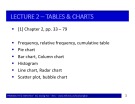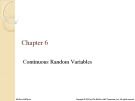
Cumulative table
-
Lecture "Probability & statistics - Chapter 2: Tables & charts" has contents: Frequency, relative frequency, cumulative table; pie chart; bar chart, column chart; histogram; line chart; radar chart; rcatter plot, bubble chart.
 24p
24p  abcxyz123_07
abcxyz123_07
 19-03-2020
19-03-2020
 17
17
 2
2
 Download
Download
-
Chapter 6 - Continuous random variables. After mastering the material in this chapter, you will be able to: Define a continuous probability distribution and explain how it is used, use the uniform distribution to compute probabilities, describe the properties of the normal distribution and use a cumulative normal table, use the normal distribution to compute probabilities,...
 15p
15p  whocare_b
whocare_b
 05-09-2016
05-09-2016
 60
60
 2
2
 Download
Download
CHỦ ĐỀ BẠN MUỐN TÌM















